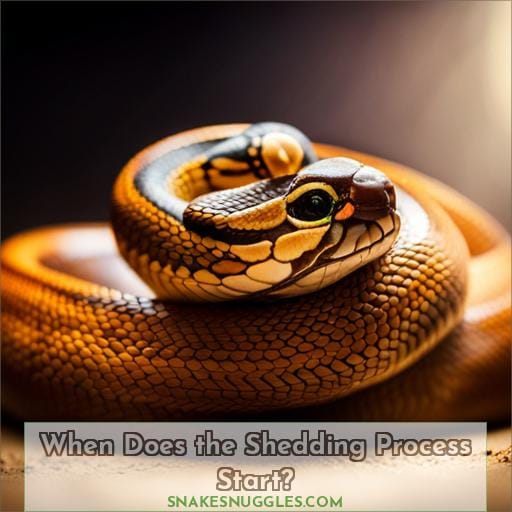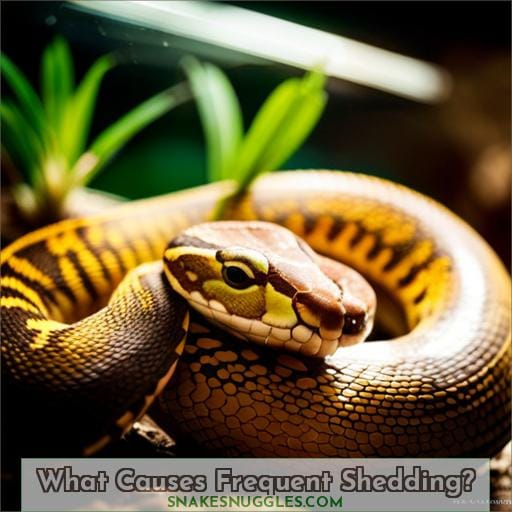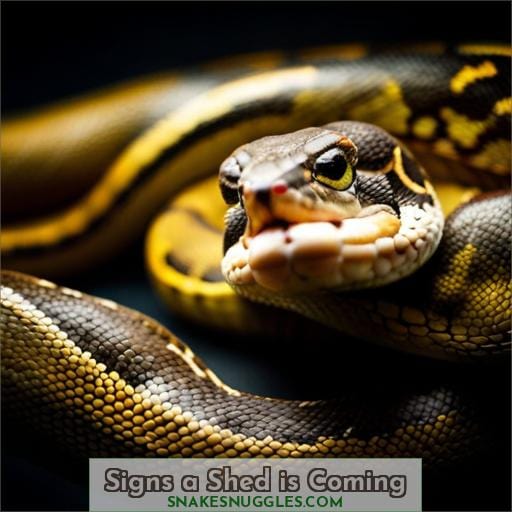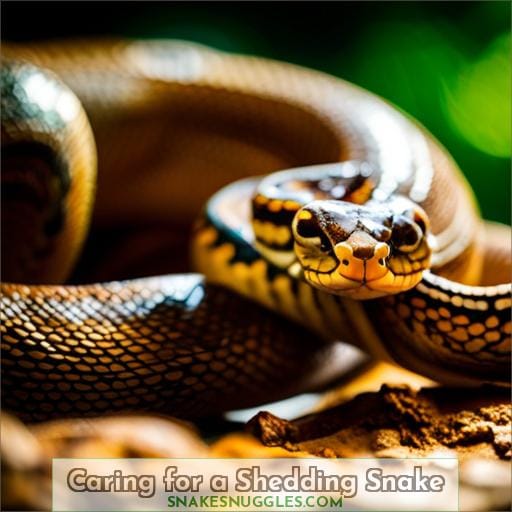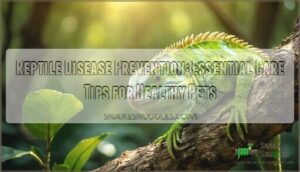This site is supported by our readers. We may earn a commission, at no cost to you, if you purchase through links.
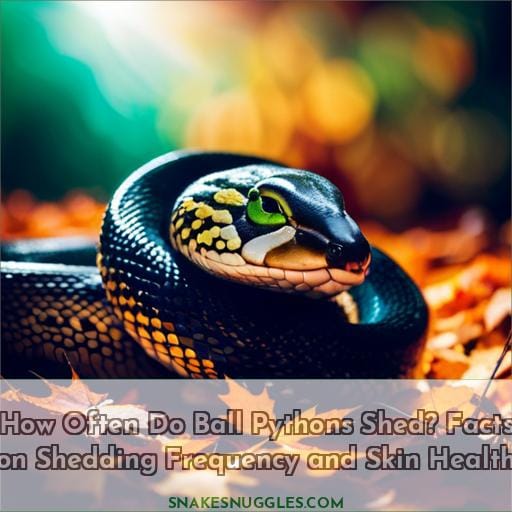 Shedding is a crucial process that ball pythons undergo to grow and maintain skin health.
Shedding is a crucial process that ball pythons undergo to grow and maintain skin health.
Every keeper should understand the shedding frequency and factors that influence it.
This article delves into the details of how often ball pythons shed, addressing common concerns like age-related shedding patterns and potential causes of frequent shedding.
By understanding these aspects, you’ll be better equipped to ensure your ball python’s shedding process is smooth and healthy.
Table Of Contents
- Key Takeaways
- How Often Do Ball Pythons Shed?
- Do Juveniles Shed More Often Than Adults?
- When Does the Shedding Process Start?
- Should I Handle a Shedding Snake?
- Should I Feed a Shedding Snake?
- What Causes Frequent Shedding?
- Signs a Shed is Coming
- Caring for a Shedding Snake
- Frequently Asked Questions (FAQs)
- How can I tell when my ball python is about to start shedding?
- Is it normal for my ball python to be more aggressive during a shed?
- What humidity level should I maintain during a shed?
- How do I remove stuck shed from my ball python?
- How long after a shed should I wait before handling my ball python again?
- Conclusion
Key Takeaways
- Healthy adult ball pythons shed every 4-6 weeks, while juveniles shed more frequently about every 3-4 weeks.
- Shedding frequency depends on the snake’s skin health, humidity, hydration, habitat cleanliness, and nutrition.
- Signs that shedding is about to occur include dull colored skin, milky blue eyes, lethargy, loss of appetite, increased soaking, and seclusion.
- Avoid handling snakes when they are shedding to prevent damaging the new skin underneath.
How Often Do Ball Pythons Shed?
Shedding their skin about every 4-6 weeks, a healthy adult ball python goes through the shedding process regularly to accommodate growth.
As the snake grows, its skin must expand.
Adult ball pythons typically shed every 4 to 6 weeks.
However, younger snakes that are growing quickly may shed more frequently, such as every 3 to 4 weeks.
Skin health and proper shedding depend on appropriate humidity and hydration.
Complications like unsanitary habitats, mites, infections, or poor nutrition can also increase shedding frequency as an indicator of skin health problems.
Monitoring shedding cycles provides insight on a ball python’s overall growth patterns and skin health.
Providing proper humidity through moist hides can facilitate clean full-body sheds.
Do Juveniles Shed More Often Than Adults?
As juveniles, ball pythons shed more frequently than adults.
Younger snakes shed every 3 to 4 weeks before their growth rate slows around 3 years old.
This increased shedding frequency in juveniles is triggered by their rapid growth spurts as they regularly outgrow their skin.
Environmental factors like temperature and humidity levels also impact shedding cycles.
With optimal conditions, juveniles shed in response to weight gain from consistent, nutritious feedings.
However, inadequate nutrition or habitat can cause abnormal shedding rates.
Monitoring juveniles for signs of impaired development based on shedding anomalies allows adjustments meeting individual needs during this crucial growth phase for ball pythons.
When Does the Shedding Process Start?
You’ll notice the shedding process starts when your ball python’s skin becomes dull and its eyes turn a milky blue.
This signals that their body is preparing to shed its skin.
Environmental factors like humidity and temperature trigger this skin regeneration process.
As the snake prepares to shed, you may notice other signs like:
- Lethargy and loss of appetite
- An increase in soaking behavior
- Seeking seclusion
These behavioral changes indicate your snake is entering the shedding phase.
By recognizing these shedding triggers and signs of skin preparation, you can properly assist your ball python during this vulnerable period until it regains its vibrant scales.
Monitoring growth rate between sheds can also help gauge your snake’s health.
Should I Handle a Shedding Snake?
One should avoid handling your ball python once you notice signs that a shed is about to occur.
As the snake’s skin becomes dull and its eyes turn blue, it’s best to stop interacting with it.
Handling precautions at this time help prevent damaging sensitive new skin underneath or causing the snake undue stress.
The snake may act defensively or bite readily when shedding since behavioral changes signify discomfort.
After the shed, the snake requires further rest before resuming normal handling.
While patience allows for renewed bonding post-shedding, pressuring interaction risks harm.
Providing proper humidity, soaking options, sanitation, and a quiet space to complete the shed ensures good health.
Once finished shedding, the snake can be handled again gently as signs of stress behaviors diminish.
Should I Feed a Shedding Snake?
Most snakes refuse food during shedding since nutrients are focused on the physiological process of renewal rather than digestion.
Avoid feeding live prey to prevent aggression if uneaten.
However, offering dead prey is acceptable, if unlikely to be eaten.
Regardless of food intake, ensure proper humidity levels between 60-80% to facilitate healthy shedding, provide a large water dish for soaking, and refrain from handling to reduce risks of regurgitation or retained eye caps.
Once indicators of shedding like blue eyes, duller scales, or increased hiding cease, offer food again, as the snake’s appetite and mood typically bounce back post-shed when the skin has fully renewed.
Through attentive humidity management spanning the ball python shedding process, the occasional skipped meal proves no cause for concern provided overall skin health remains robust.
What Causes Frequent Shedding?
If your ball python is shedding more often than every 3-4 weeks as a juvenile or 4-6 weeks as an adult, this could indicate an underlying problem.
Frequent shedding may result from:
- Improper humidity levels in the enclosure
- Parasitic infestations like mites or ticks
- Scale diseases like scale rot
Closely monitor the snake and its environment to determine the cause of frequent shedding.
Improper Humidity Levels
You’re asking for frequent shedding if you don’t maintain proper humidity levels for your ball python.
Not providing enough moisture leads to dry skin, causing the snake to shed more often to replace damaged tissue.
Use substrates holding humidity, mist enclosures, or offer a humid hide to keep skin hydrated.
Parasitic Infestations
You’d also shed more often if mites or ticks take up residence on your skin.
These parasites irritate the skin, disrupting normal shedding cycles.
Mite prevention and tick identification can help avoid shedding troubles.
Providing proper humidity solutions promotes healthy skin and regulates shedding frequency in ball pythons needing to soak.
Scale Disease Presence
The presence of fungal or bacterial scale disease on your snake’s skin can also trigger frequent shedding cycles as its body attempts to heal itself, which can be caused by a variety of factors such as poor hygiene. Check for shedding problems.
Seek veterinary care for proper diagnosis and treatment options.
Maintain proper humidity levels and sanitation.
Use preventive measures like quarantining new snakes.
Signs a Shed is Coming
You may notice your ball python developing reddish-brown patches from scale rot, signaling the presence of underlying skin issues. You’ll notice your ball python’s dulling scales and blue-tinted eyes as the shed approaches.
The snake’s skin will appear faded, dry, and wrinkled. Its eyes will turn a hazy bluish-white color as the old spectacles begin to separate.
Becoming more restless and fidgety, your ball python may start exploring its enclosure more actively instead of lounging in its hides. Its appetite will also likely decrease or vanish completely in the final days before shedding.
Not wanting to be handled, the snake may be more defensive and nippy. Seeking isolation, privacy, and higher humidity, your ball python will hide away in enclosed spaces during this sensitive period when it’s most vulnerable.
Monitoring for these signals allows you to properly support your snake’s shedding process.
Caring for a Shedding Snake
Provide a humid hiding area when your ball python enters a shed cycle.
Offer a large water dish for soaking.
Don’t handle the snake until after the shed is complete.
Monitoring humidity levels and limiting contact will support healthy shedding.
Provide Humidity
Increase the humidity in your snake’s enclosure by adding a humid hide box so its old skin can come off cleanly.
Use a plastic container with a hole cut out.
Fill with damp sphagnum moss.
Mist the enclosure daily.
Offer Water Dish
Provide your shedding snake with a shallow water dish for soaking to aid the shedding process.
Strategies like a humidity chamber also promote healthy shedding.
Focus on skin health with proper humidity and hydration.
Don’t Handle
Never handle a ball python while it’s shedding its skin.
Shedding challenges mobility and vision.
Handling concerns like abrasions can harm the snake.
Feeding dilemmas from appetite loss exist.
Growth variations mean frequent shedding.
Health precautions like avoiding handling ensure snake safety.
When your ball python’s shedding its skin, keep its enclosure’s humidity up by offering a water dish and avoid handling it.
Maintaining proper humidity levels during shedding can help prevent common challenges like stuck shed.
Aim for 60-80% humidity by providing a large, shallow water dish for soaking and using moist substrates.
Ignore myths that pulling off stuck shed helps the snake; this can damage its new skin.
Expect behavioral changes too. Your snake may seem more defensive or go off food while shedding.
Ensure proper husbandry and nutrition to support healthy shedding cycles.
Frequent sheds in juveniles simply reflect rapid growth.
With some humidity and hands-off time, your ball python can shed its old skin smoothly.
Frequently Asked Questions (FAQs)
How can I tell when my ball python is about to start shedding?
Look for dulling scales, blue-tinted eyes, lethargy, loss of appetite, and more defensive behavior.
Your ball python is preparing to shed its skin.
Is it normal for my ball python to be more aggressive during a shed?
Yes, it’s normal for ball pythons to become more aggressive while shedding.
Their eyes turn blue, so visibility decreases, causing them to be more defensive.
Handle the snake as little as possible until after the shed is complete.
What humidity level should I maintain during a shed?
To aid shedding, maintain a humidity level of 60-80%.
Lightly mist the enclosure daily.
This prevents stuck shed and allows the old skin to peel off smoothly.
After the old skin has peeled off, you can resume normal humidity levels of 40-60%.
How do I remove stuck shed from my ball python?
Soak your ball python in lukewarm water for 10-15 minutes to loosen any stuck shed.
Then, gently peel it off with tweezers, working with the snake’s scales.
Never forcefully pull off shed skin.
How long after a shed should I wait before handling my ball python again?
Wait at least 24 hours after your ball python completes shedding before gently handling it again.
This allows its new skin layer to fully settle without the risk of damaging fragile areas.
Then, resume normal handling routines.
Conclusion
To ensure your ball python sheds smoothly:
- Closely monitor humidity and hydration.
- Avoid handling during the shedding process.
If frequent shedding occurs:
- Scrutinize husbandry conditions.
- Watch for signs of infestation or scale disease.
With diligent observation and care, you can maintain the regular shedding vital to your snake’s health and development.
When shed cycles follow their normal pattern, it confirms your dedication to providing a comfortable habitat.


